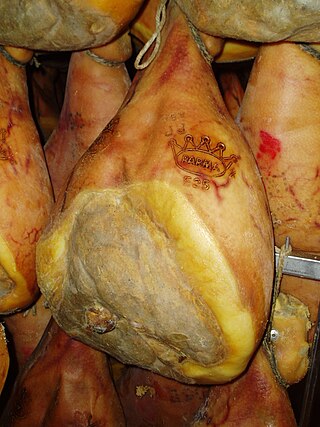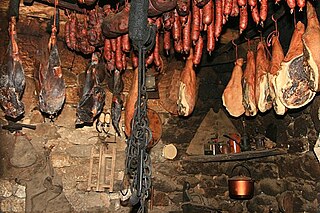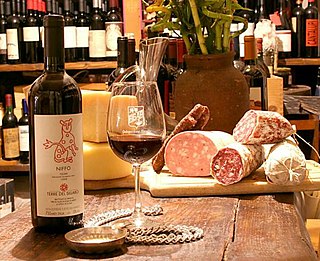
Ham is pork from a leg cut that has been preserved by wet or dry curing, with or without smoking. As a processed meat, the term "ham" includes both whole cuts of meat and ones that have been mechanically formed.

Bacon is a type of salt-cured pork made from various cuts, typically the belly or less fatty parts of the back. It is eaten as a side dish, used as a central ingredient, or as a flavouring or accent.

Polish cuisine is a style of food preparation originating in and widely popular in Poland. Due to Poland's history, Polish cuisine has evolved over the centuries to be very eclectic, and shares many similarities with other national cuisines. Polish cooking in other cultures is often referred to as à la polonaise.

Austrian cuisine is a style of cuisine native to Austria and composed of influences from Central Europe and throughout the former Austro-Hungarian Empire. Austrian cuisine is most often associated with Viennese cuisine, but there are significant regional variations.

Prosciutto crudo, in English often shortened to prosciutto, is uncooked, unsmoked, and dry-cured ham. Prosciutto crudo is usually served thinly sliced.

Bresaola is air-dried, salted beef that has been aged two or three months until it becomes hard and turns a dark red, almost purple color. It is made from top (inside) round, and it is lean and tender, with a sweet, musty smell. It originated in Valtellina, a valley in the Alps of northern Italy's Lombardy region.

Smoked meat is the result of a method of preparing red meat, white meat, and seafood which originated in the Paleolithic Era. Smoking adds flavor, improves the appearance of meat through the Maillard reaction, and when combined with curing it preserves the meat. When meat is cured then cold-smoked, the smoke adds phenols and other chemicals that have an antimicrobial effect on the meat. Hot smoking has less impact on preservation and is primarily used for taste and to slow-cook the meat. Interest in barbecue and smoking is on the rise worldwide.

Pancetta is a salt-cured pork belly meat, product in a category known as salume. In Italy, it is often used to add depth to soups and pastas.

Italian cuisine is a Mediterranean cuisine consisting of the ingredients, recipes and cooking techniques developed in Italy since Roman times and later spread around the world together with waves of Italian diaspora. Some of these foods were imported from other cultures. Significant changes occurred with the colonization of the Americas and the introduction of potatoes, tomatoes, capsicums, maize and sugar beet—the latter introduced in quantity in the 18th century. It is one of the best-known and most appreciated gastronomies worldwide.

Black Forest ham is a variety of dry-cured smoked ham produced in the Black Forest region of Germany.

Salumi are Italian meat products typical of an antipasto, predominantly made from pork and cured. Salumi also include bresaola, which is made from beef, and some cooked products, such as mortadella and prosciutto cotto.

Hungarian sausages are sausages found in the cuisine of Hungary. Hungary produces a vast number of sui sausage types. They may be boiled, fresh or dried, and smoked, with different spices and flavors, "hot" or "mild". Many were influenced by their neighbors and brethren.
Ammerländer Schinken – or Ammerländer Knochenschinken – is a type of dry-cured ham produced in the Ammerland area of North Germany. It has PGI status under EU law.

Venetian cuisine, from the city of Venice, Italy or more widely from the region of Veneto, has a centuries-long history and differs significantly from other cuisines of northern Italy, and of neighbouring Austria and of Slavic countries, despite sharing some commonalities.

Speck Alto Adige PGI is a dry-cured, lightly smoked ham produced in South Tyrol, northern Italy. Parts of its production are regulated by the European Union under the protected geographical indication (PGI) status.

Speck can refer to a number of European cured pork products, typically salted and air-cured and often lightly smoked but not cooked. In Germany, speck is pickled pork fat with or without some meat in it. Throughout much of the rest of Europe and parts of the English-speaking culinary world, speck often refers to South Tyrolean speck, a type of Italian smoked ham. The term "speck" became part of popular parlance only in the eighteenth century and replaced the older term "bachen", a cognate of "bacon".
















